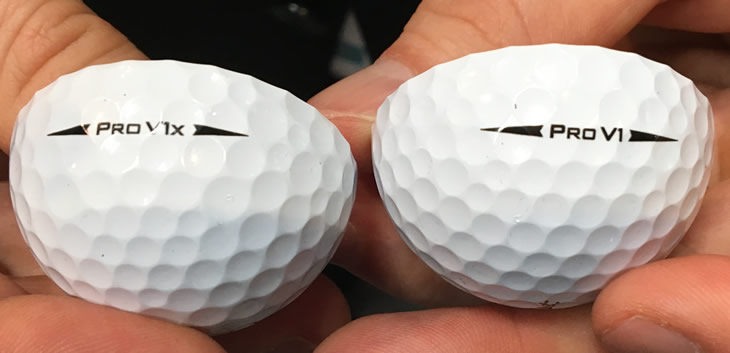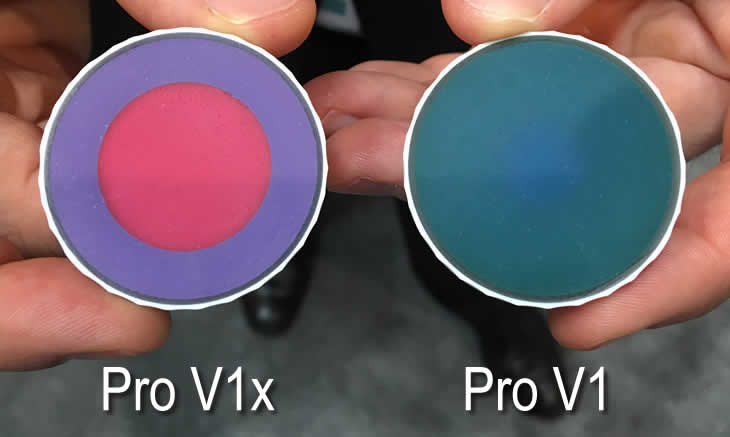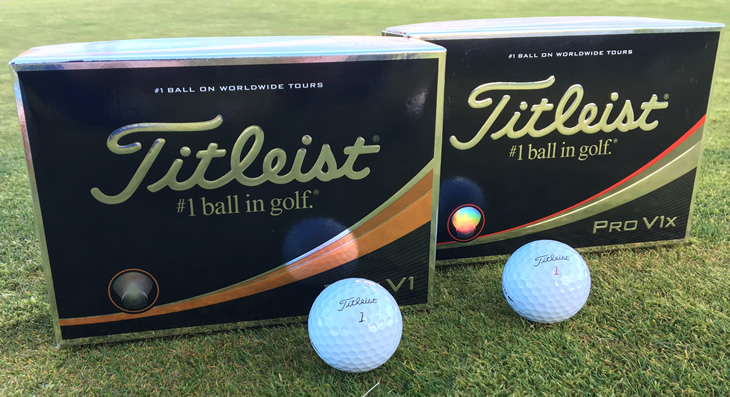I caught up with Matt Hogge, R&D Director of Golf Ball implementation at the 2017 PGA Merchandise Show to find out what changes have been made to the latest generation of the Pro V1 and Pro V1x.

Hi Matt. What is the main difference between the 2017 Pro V1 and the previous generation of balls?
The main difference is the core formulation and the improved aerodynamic consistency. The core formulation change decreases spin and increases ball speed which is a recipe for longer distance and the big change is that the Pro V1 is now longer.
The other change in Pro V1 is the improved aerodynamic consistency. We used a combination of new equipment to make the dimples, which means that from ball to ball it is more consistent than ever in terms of our tooling and on top of that we reduced the size variation of the dimples on Pro V1 from five sizes to four sizes which reduced the overall variation on the ball for a tighter flight window.
So the new ball is longer and it is more consistent with a tighter flight window.
The ball still has the same number of dimples?
Yes, the Pro V1 ball still has the same number of dimples, 352, but a decrease in size and an improvement in our ability to make the hobs which make the cavities so there is less variation ball to ball and dozen to dozen.
So you make the hobs in the US and then send them over to the factory where the balls are made?
Yes we have two facilities that we built, own and operate. Ball Plant 3 is in the Greater New Bedford area in Massachusetts and Ball Plant 4 is in Thailand. We make all of our tooling for all of our golf balls in a little facility just outside of Ball Plant 3. We make the hobs there from which me make the cavities and we then ship the cavities to our manufacturers.
How did you decide that improving the consistency of flight would be a key factor in improving the ball?
We are in a two year development cycle where we know that every two years we are going to come out with a new Pro V1 & Pro V1x to meet the market demand and expectations. We have our R&D team which is constantly working on core formulation changes and aerodynamic improvements and we felt that at this time for the launch of this ball we had an aerodynamic improvement that we could provide to the Pro V1.
We knew from Team Titleist testing, Tour Player responses and PGA professionals throughout the pyramid of influence were asking for the Pro V1 to become longer, but they didn’t know we were also working on an aerodynamic project that had been in the works since 2011, where we introduced a dimple pattern based on the spherically tiled tetrahedrons, so those things finally came together.

Is the aerodynamic improvement more to do with the improvement in the manufacturing process or due to the design itself?
It’s two-fold. We purchased a new piece of equipment and we started making hobs that enables us to make the cavities and that is where we are really seeing reduced variation hob to hob. We make a lot of Pro V1 and Pro V1x golf balls so we need more than just one hob to make the cavities, we need several to hobs to make all the cavities, so hob to hob each one in identical to the next which is what improves the consistency. At the same time we also had our aerodynamic engineers looking at size changes of the dimples so it is the two things side by side that work together to improve the aerodynamics of the ball.
Are both the balls softer for 2017 or is it just the Pro V1?
The Pro V1. That is the really interesting part, the Pro V1 is still softer than the Pro V1x. We talked about the core formulation change in the Pro V1. By making that change we didn’t increase the compression to get that increase in ball speed so Pro V1 still has the same great feel.
Pro V1x only has the improved aerodynamic consistency changes, and that is because the Tour players and better players on Team Titleist and PGA Professionals told us not to change anything with the Pro V1x.
Then they said something kind of curious at the end, that there are times when they hit a shot and it spins up just a bit and that is when we knew that we had this consistency improvement in the aerodynamics, so we bolted that onto the product and that really fixed that issue that we had heard from players like Jimmy Walker and Jordan Spieth.

So there have been more changes in Pro V1 than in the Pro V1x for 2017. Now when you are discussing the balls together they differ by spin, feel and flight. The Pro V1 spins less than Pro V1x, in feel, the Pro V1 feels softer than Pro V1x and in flight, and the Pro V1 flies lower than Pro V1x.
So the Pro V1 spins less than the Pro V1x?
Exactly. I saw your eyebrows raise and knew that was going to be the next question! The Pro V1 now spins less than the Pro V1x, which is not how it has been in the past.
Is this the first time this has happened?
It is the first time and it flipped in response to the golfers who asked for more distance and they asked for less spin in the Pro V1. It is really in the longer distance shots with the driver and the irons where the core formulation is getting a speed increase and a spin decrease but without giving up any spin on the shots into and around the green. So the ball has the same great short game control that it had in 2015.
With our core formulations we are able to decrease spin and add speed, but not impact the short game and that is paramount to making good golf balls, having the formulation and expertise to be able to do that, and we have 80 people in golf ball R&D who can make that happen.
With the 2017 balls if you thought you were always a Pro V1x player we are asking you to re-evaluate your decision. If you were playing Pro V1x for distance then the fact is the balls are now equal so you should make your decision based on feel and flight and spin and choosing on those factors will help you make a better decision for your game.
Is Pro V1x spinning the same as before?
With Pro V1x, because we only made the aerodynamic changes, there is no spin increase or decrease on the 2015 ball, as dimples do not control spin. The Pro V1 relative to the previous generation Pro V1 spins less and relative to the Pro V1x spins less.

A more general question. How has the Pro V1 market share changed?
If you look at our entire business with Pro V1 and Pro V1x it is really 50/50. For a lot of people that is surprising because on the major tours there has been a high volume of Pro V1x players. What we are seeing based on players now putting the Pro V1 into play that may shift based on what we are now seeing. What was originally 75/25 might be closer to 50/50.
We are now seeing some 4 piece urethane cover balls on the market at a lower price point. Do you think that will be a threat to Pro V1 or will it be more of a threat to the existing 2-piece balls in the market.
One of the key things that differentiates Titleist is that we only operate and manufacture our own golf balls in our own factories, from the tooling to the final printing of the script, is all done by Titleist employees and under our control. That key point of difference gives us the quality and consistency that we believe every golfer wants and when they think about that it helps them make a decision about what golf balls they want to buy.
There might be other companies selling what they consider to be a premium golf ball at a lower price but they might not be manufacturing them So that is why we feel our quality and our consistency is the best in the business.